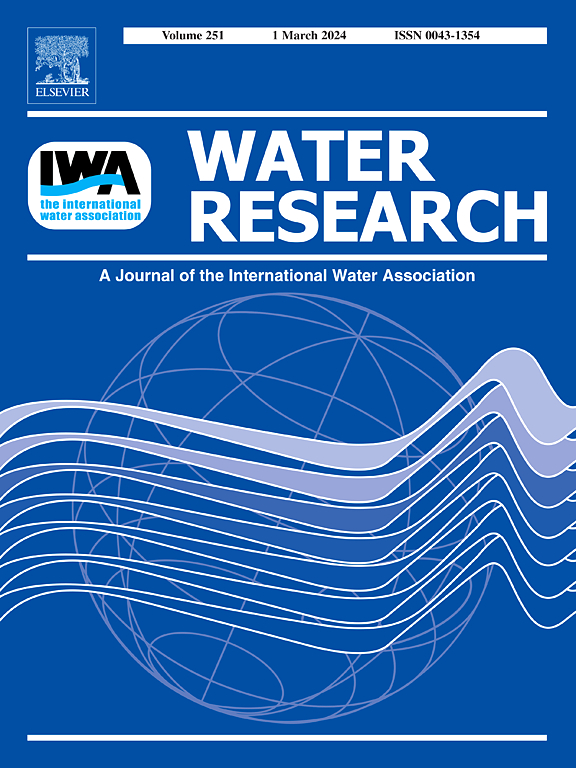Enhanced seawater uranium extraction via flow capacitive deionization by amidoxime-functionalized MXene/CoZn-MOF heterostructure electrodes
IF 12.4
1区 环境科学与生态学
Q1 ENGINEERING, ENVIRONMENTAL
引用次数: 0
Abstract
Uranium is an essential resource for the development of sustainable nuclear industry. Flow electrode capacitive deionization (FCDI) is a promising technology for uranium extraction from natural seawater to meet the uranium shortage, due to its superior ion capture ability and continuous operation capability. Here, amidoxime-functionalized MXene/CoZn-MOF heterojunction electrodes (MMA) are designed for FCDI uranium extraction. The MMA features a hierarchical porous structure and large internal active surface area, which provide extensive mass transport pathways. Meanwhile, the amidoxime groups ensure high uranyl selectivity. Accordingly, MMA electrodes achieve a superior uranium adsorption capacity of 2322.4 mg g−1 and remove 95.6 % uranium from 500 mg L−1 solution using an applied voltage of 1.2 V within 2 h. In a non-circulating mode, the MMA exhibits a uranium adsorption rate of 1.43 mg g−1 day−1 from seawater desalination concentrate (SDC). Additionally, the MMA retain a 90.5 % removal efficiency even after 20 reuse cycles. The density functional theory and molecular dynamics simulation results indicate that the efficient charge-transfer channels of the heterojunction and strong chelation of amidoxime groups contribute to improving the uranium adsorption capacity and selectivity. Our findings unravel underlying mechanisms of FCDI and provide valuable insights for designing electric field assisted uranium extraction.


偕胺肟功能化MXene/CoZn-MOF异质结构电极流动电容去离子强化海水铀萃取
铀是可持续核工业发展的重要资源。流动电极电容去离子(FCDI)以其优异的离子捕获能力和连续操作能力,是解决天然海水中铀短缺的一种很有前途的提铀技术。本文设计了偕胺肟功能化MXene/CoZn-MOF异质结电极(MMA)用于FCDI铀萃取。MMA具有分层多孔结构和较大的内部活性表面积,提供了广泛的物质运输途径。同时,偕胺肟基保证了高的铀酰选择性。因此,在1.2 V电压下,MMA电极在2小时内达到2322.4 mg g−1的铀吸附量,从500 mg L−1溶液中去除95.6%的铀。在非循环模式下,MMA对海水淡化精矿(SDC)的铀吸附率为1.43 mg g−1 day−1。此外,即使在20次重复使用循环后,MMA仍保持90.5%的去除效率。密度泛函理论和分子动力学模拟结果表明,异质结的高效电荷转移通道和偕胺肟基团的强螯合作用有助于提高铀的吸附能力和选择性。我们的发现揭示了fdi的潜在机制,并为设计电场辅助铀矿开采提供了有价值的见解。
本文章由计算机程序翻译,如有差异,请以英文原文为准。
求助全文
约1分钟内获得全文
求助全文
来源期刊

Water Research
环境科学-工程:环境
CiteScore
20.80
自引率
9.40%
发文量
1307
审稿时长
38 days
期刊介绍:
Water Research, along with its open access companion journal Water Research X, serves as a platform for publishing original research papers covering various aspects of the science and technology related to the anthropogenic water cycle, water quality, and its management worldwide. The audience targeted by the journal comprises biologists, chemical engineers, chemists, civil engineers, environmental engineers, limnologists, and microbiologists. The scope of the journal include:
•Treatment processes for water and wastewaters (municipal, agricultural, industrial, and on-site treatment), including resource recovery and residuals management;
•Urban hydrology including sewer systems, stormwater management, and green infrastructure;
•Drinking water treatment and distribution;
•Potable and non-potable water reuse;
•Sanitation, public health, and risk assessment;
•Anaerobic digestion, solid and hazardous waste management, including source characterization and the effects and control of leachates and gaseous emissions;
•Contaminants (chemical, microbial, anthropogenic particles such as nanoparticles or microplastics) and related water quality sensing, monitoring, fate, and assessment;
•Anthropogenic impacts on inland, tidal, coastal and urban waters, focusing on surface and ground waters, and point and non-point sources of pollution;
•Environmental restoration, linked to surface water, groundwater and groundwater remediation;
•Analysis of the interfaces between sediments and water, and between water and atmosphere, focusing specifically on anthropogenic impacts;
•Mathematical modelling, systems analysis, machine learning, and beneficial use of big data related to the anthropogenic water cycle;
•Socio-economic, policy, and regulations studies.
 求助内容:
求助内容: 应助结果提醒方式:
应助结果提醒方式:


